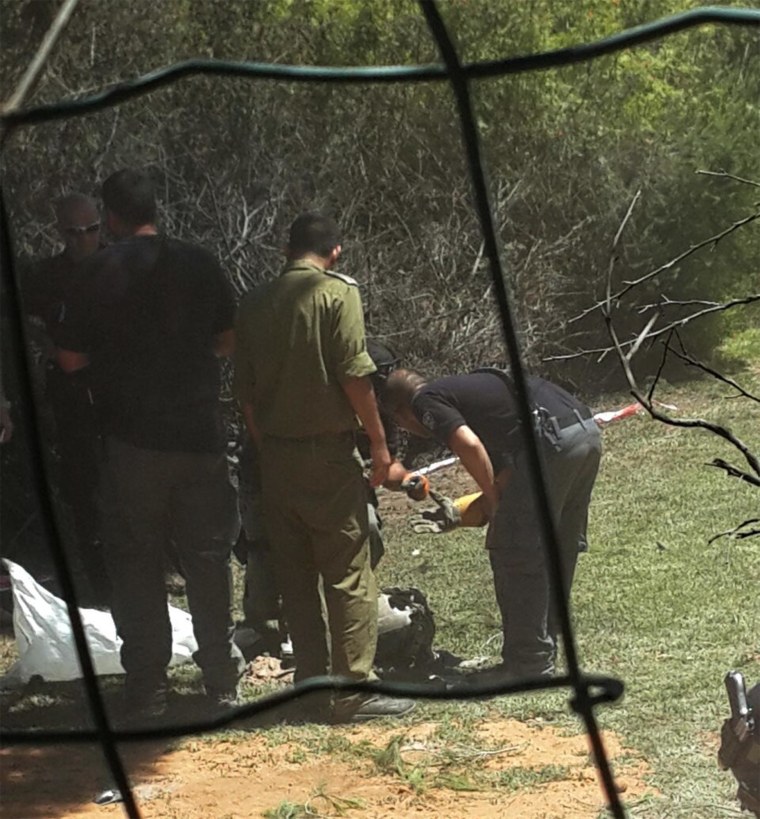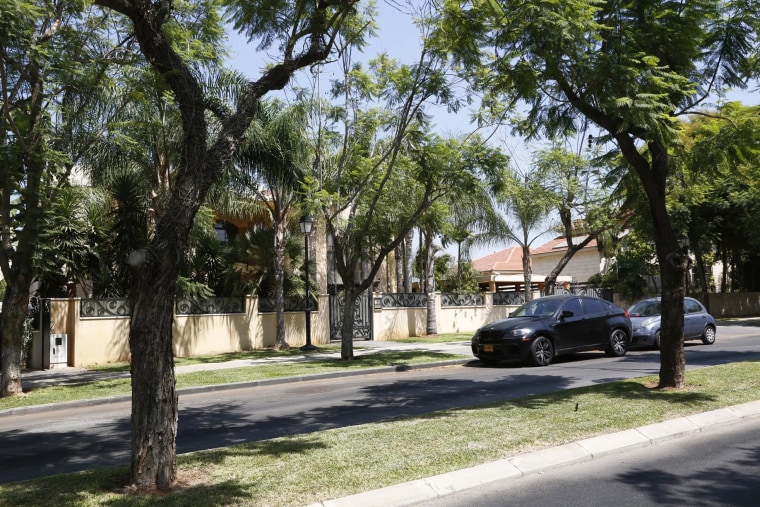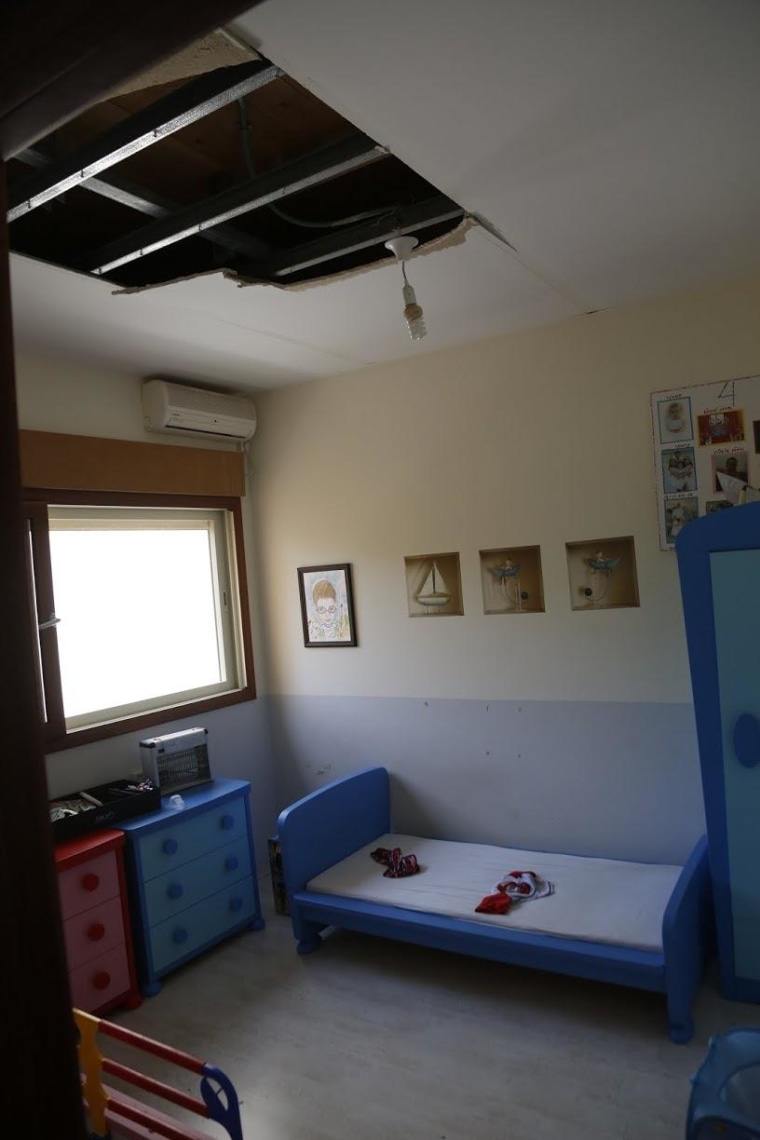Two days after the United States lifted a politically sensitive ban on flights into Israel, Hamas fired three rockets toward the Tel Aviv airport.
An alarm sounded inside the terminal, sending passengers scurrying for shelter. An Air Canada plane that was making its final approach was ordered to lift off again and circle until it was cleared to land safely.
An Israeli military spokeswoman later told reporters that two of the rockets were intercepted by Iron Dome, the Israeli air-defense system. She would not say where the third landed.
It struck in a leafy, well-off suburb, three miles from the airport, damaging homes and terrifying people who live in the neighborhood, who said that they could have been killed had they not fled to shelter rooms.

Israeli officials told NBC News that they do not use Iron Dome in that area, particularly when planes are inbound — a calculation that balances Israel’s desire to protect planes flying into Tel Aviv against the safety of Israeli citizens.
“The Israeli Air Force deeply understands the safety concerns of the civilian aviation industry, and they are ready to accept the public anger that will result if a rocket lands in a populated area,” said Giora Romm, director general of the civil aviation authority.
That calculation, and the fact that a Hamas rocket got through just after the United States lifted its flight suspension, led some Israelis who live near the airport to say that their safety was being sacrificed to protect air traffic.
The rocket exploded late, Israeli officials said. Otherwise it would have been more dangerous.
Iris Zilberman, who lives next door to the house where the rocket landed that day, July 25, showed NBC News a child’s room where the shock wave from the rocket caused part of the ceiling to collapse. She said she believed that the air force wasn’t shooting down missiles near the airport for fear that fragments from the collision would land on the nearby runway.
“We are living here in a state of terror,” she said.
Sensitive time
The United States banned its airlines from flying into Ben Gurion Airport, in Tel Aviv, on July 22 after a separate rocket landed about a mile from the airport.
The flight suspension angered the Israeli government, which said that the United States was handing Hamas a propaganda victory. Israel, surrounded by Arab states, considers any threat to air traffic a serious strategic threat.
The suspension was lifted the following day. Federal Aviation Administration officials said they had received assurances from Israel that the airport and the surrounding area were well protected from incoming rockets.
Two days after that, just before noon on July 25, Hamas fired the three rockets. The Israeli press was asked not to report on what became a closely guarded secret — that one of them landed in the backyard of a home in the suburb, called Savion.

Yigal Roda, who lives nearby, said that his children were in the swimming pool just before noon when he heard a siren. He said he first thought, “It won’t happen to me.” Then, he said, he reconsidered and told the kids: “Run quickly.”
The children ran, without towels or clothes, to a shelter room, he said. He said the rocket landed several feet from him. The shock wave stopped the clock hanging outside his home. It still shows the time of impact, 11:45 a.m.
U.S. aware
The Federal Aviation Administration said that it was aware of the rocket landing, and that it had spoken with its counterparts in Israel, who discussed their handling of the episode.
“Israeli security and response procedures worked as intended, and the rocket did not hit or come near the airport,” the FAA said in a statement to NBC News.
“There is an open line of communication between FAA and Israeli aviation authorities to use as needed,” the statement went on. “We continue to closely monitor the situation in Israel and are regularly communicating with our air carriers.”
Romm, the Israeli civil aviation official, said that the Israeli air force generally does not fire Iron Dome interceptors at a section of airspace north of the airport, the approach that the tower tells planes to use in times of heightened rocket danger.

It appears that what happened in those dramatic moments on July 25 was just that: The Air Canada plane was coming in to land from the north when the Hamas rockets were fired.
Israeli authorities took two steps to protect the flight — sending it soaring back into the sky instead of allowing it to land and choosing not to fire Iron Dome interceptors to knock out the third rocket.
“Look, the Iron Dome interceptors are very clever,” said Romm, the aviation official, himself a former fighter pilot. “They can tell the difference between a plane and a rocket and will not bring down a plane.”
But he said that, as a precaution, the air force “generally doesn’t fire any rockets towards the quadrant north of the airport.”
People who live just north of the airport say they never received confirmation of their suspicion that they are left without Iron Dome protection in order to keep the planes flying in.
“If it would have exploded, 15 houses would have been blown away here,” Roda, the neighbor, said in an interview. “Blown right up in the air. People would have died. This is an area of private houses. Everything could have collapsed.”
Decision to lift ban
After the U.S. announced its flight suspension, inconveniencing thousands of travelers during the Israeli summer tourist season, Israel and its supporters applied public pressure to the United States to reverse the decision quickly.
As soon as the suspension was declared, Israeli Prime Minister Benjamin Netanyahu placed an urgent call to Secretary of State John Kerry to discuss the decision, and several prominent Israeli and American politicians denounced it.
Michael Bloomberg, the former New York mayor, hopped a flight to Tel Aviv aboard the Israeli airline El Al on the night of July 22 to make his point. He was met on the tarmac by Netanyahu, who thanked him.
“We protect this airport. There’s no reason whatsoever for the mistaken FAA decision to instruct American planes not to come here,” Netanyahu told Bloomberg in front of reporters. “I think this decision only rewards the Hamas terrorists for nothing.”
The FAA, in lifting the ban on July 23, said it had assessed security in Israel and reviewed measures that the Israeli government had taken to curtail the risks to civilian aircraft.
Romm wrote a memo assuring the FAA, international airlines and other aviation groups that flights to and from Israel were safe. He said that the personally walked FAA officials through Israel’s defensive systems and procedures.
“I want to believe that it was a convincing presentation because they changed their ruling,” he said.
That memo said that Israel had decided not to use Iron Dome to intercept the July 22 rocket, the strike that led American officials to suspend flights to Israel.
The memo said that Iron Dome has a “remarkable ability” to predict the trajectory of an incoming rocket, and to launch intercepting rockets with a 99 percent accuracy rate, within the three and a half minutes it takes for a rocket to fly from Gaza to central Israel.
It estimated that the chance of an incoming rocket hitting a plane on the tarmac was about one in 100 million, and that the chance of a rocket hitting a plane in flight was even lower, about one in a billion.
The memo was first reported by the Israeli newspaper Haaretz.
Roda, the neighbor, said that he still wondered why the Israeli government didn’t shoot down the rocket. He said that his family ate and slept in a shelter room for four nights after the rocket strike, and that his wife now has panic attacks.
“Why not intercept it?” he said. “If not for that wall, that rocket would be in my back when I sat here, on this chair.”
Jay Blackman of NBC News contributed to this report.